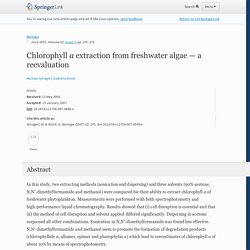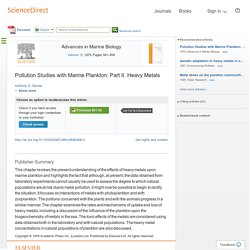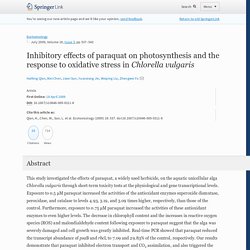

Pages586 593. Chlorophyll a extraction from freshwater algae — a reevaluation. Abaychi J.K.

& Riley J.P. 1979. The determination of phytoplankton pigments by high-performance liquid chromatography. Anal. Chim. Acta 107: 1–11.CrossRefBidigare R.R., Kennicutt II M.C. & Brooks J.M. 1985. Studies on Photosynthesis, the Associated Electron Transport System and Some Physiological Variables of Chlorella vulgaris Under Heavy Metal Stress. Comparative Studies on the Green Algae Chlorella homosphaera and Chlorella vulgaris with Respect to Oil Pollution in the River Nile. Algal growth inhibition of Chlorella pyrenoidosa by polar narcotic pollutants: toxic cell concentrations and QSAR modeling. Research Institute of Toxicology (RITOX), Environmental Toxicology and Chemistry Section, Utrecht University, P.O.

Box 80.176, NL-3508 TD Utrecht, The Netherlands Received 5 June 1998, Revised 5 July 1998, Accepted 21 August 1998, Available online 28 April 1999 Choose an option to locate/access this article: Check if you have access through your login credentials or your institution Check access Get rights and content Abstract The effects of 11 polar narcotic pollutants (phenols, nitrobenzenes and anilines) on the algae Chlorella pyrenoidosa have been investigated in 72 h population growth inhibition tests.
Keywords Polar narcosis; Algae; Quantitative structure–activity relationships; Phenols; Anilines; Nitrobenzenes; Toxic cell concentrations. Pollution Studies with Marine Plankton: Part II. Heavy Metals. Anthony G.

Davies The Laboratory, Marine Biological Association, Plymouth, England Available online 15 May 2008 Choose an option to locate/access this article: Check if you have access through your login credentials or your institution Check access Get rights and content This chapter reviews the present understanding of the effects of heavy metals upon marine plankton and highlights the fact that although, at present, the data obtained from laboratory experiments cannot usually be used to assess the degree to which natural populations are at risk due to metal pollution, it might now be possible to begin to rectify the situation. Comparative sensitivity of Scenedesmus acutus and Chlorella pyrenoidosa as sentinel organisms for aquatic ecotoxicity assessment: Studies on a highly polluted urban river - Olguín - 2000 - Environmental Toxicology. The effects of spatial and temporal differences on the water quality of the urban contaminated Reconquista River (Argentina) were evaluated by means of bioassays based on the growth of two algal populations (Chlorella pyrenoidosa and Scenedesmus acutus).

The effects produced by the addition of cadmium and/or nutrient salts to the samples were also assayed. Noticeable differences in algal biomass were detected among samples from different sites, the highest values corresponding to the most polluted zones. The toxic effect of cadmium was more pronounced in S. acutus than in C. pyrenoidosa, particularly in the least polluted waters.
The addition of nutrient salts to the culture medium attenuated heavy metal toxicity, mainly to C. pyrenoidosa, and also revealed nutrient limitation to algal growth in certain sites and dates. Site classifications based both on algal bioassays and on physical and chemical variables showed good agreement. ©2000 John Wiley & Sons, Inc. Effects of copper, chromium and nickel on growth, photosynthesis and chlorophyll a synthesis of Chlorella pyrenoidosa 251. THE EFFECT OF POLLUTION ON RIVER ALGAE - Palmer - 1963 - Annals of the New York Academy of Sciences. Inhibitory effects of paraquat on photosynthesis and the response to oxidative stress in Chlorella vulgaris. Authors Haifeng Qian, Haifeng QianCollege of Biological and Environmental EngineeringZhejiang University of TechnologyWei Chen, Wei ChenCollege of Biological and Environmental EngineeringZhejiang University of TechnologyLiwei Sun, Liwei SunCollege of Biological and Environmental EngineeringZhejiang University of TechnologyYuanxiang Jin, Yuanxiang JinCollege of Biological and Environmental EngineeringZhejiang University of TechnologyWeiping Liu, Weiping LiuCollege of Biological and Environmental EngineeringZhejiang University of TechnologyZhengwei FuZhengwei FuCollege of Biological and Environmental EngineeringZhejiang University of Technology Article First Online: 18 April 2009 Received: Accepted: DOI: 10.1007/s10646-009-0311-8 Cite this article as: Qian, H., Chen, W., Sun, L. et al.

Abstract Keywords Chlorella vulgarisParaquatReal-time PCRGene transcript Unlimited access to full article Instant download (PDF) Price includes local sales tax if applicable Copyright information. The effects of water-soluble petroleum components on the growth of Chlorella vulgaris Beijerinck. Carbon dioxide fixation by Chlorella kessleri, C. vulgaris, Scenedesmus obliquus and Spirulina sp. cultivated in flasks and vertical tubular photobioreactors. Authors Michele Greque de Morais, Michele Greque de MoraisLaboratory of Biochemical Engineering, Department of ChemistryFederal University Foundation of Rio GrandeJorge Alberto Vieira CostaJorge Alberto Vieira CostaLaboratory of Biochemical Engineering, Department of ChemistryFederal University Foundation of Rio Grande Original Research Paper First Online: 15 May 2007 Received: Revised: Accepted: DOI: 10.1007/s10529-007-9394-6 Cite this article as: de Morais, M.G.

& Costa, J.A.V. Abstract CO2 at different concentrations were added to cultures of the eukaryotic microalgae, Chlorella kessleri, C. vulgaris and Scenedesmus obliquus, and the prokaryotic cyanobacterium, Spirulina sp., growing in flasks and in a photobioreactor. Keywords. Chlorella for protein and biofuels: from strain selection to outdoor cultivation in a Green Wall Panel photobioreactor.